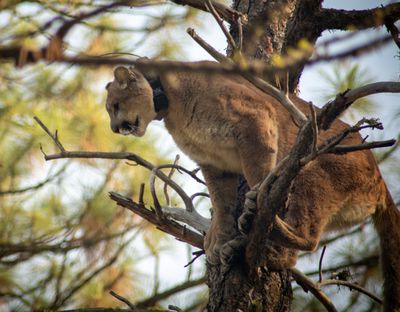Washington Fish and Wildlife Commission splits over cougar hunting rules

The Washington Fish and Wildlife Commission finds itself deeply divided over predator hunting rules for the second time in recent years.
At a meeting in Olympia last week, a majority of the nine-member panel that sets policy for the Washington Department of Fish and Wildlife disregarded pleas from a minority faction and approved a prescriptive motion directing agency officials to craft new cougar hunting rules.
The motion directed staff of the agency to bring back a proposed rule that establishes a single cougar season running from Sept. 1 to March 31 and limits hunter harvest, safety and livestock removals to 13% of the estimated mountain lion population. However, the proposed structure would, for at least next year, allow cougar hunting areas where 13% or more of the estimated population has already been removed by Sept. 1 through control actions to limit livestock killings and public safety, to open and run until it hits 20%.
As it is now structured, the season runs in two parts – September through December and then, if quotas allow, from January through April – and cougars removed for public safety or livestock attacks do not count against hunting quotas
Members in the minority asked their fellow commissioners to slow the process and wait a year, noting wildlife managers from the agency said the population does not appear in imminent danger. They said waiting would make them more comfortable and foster wider public trust in the process.
Cougar populations are difficult to monitor with precision but the department assumes a medium density of 2.3 per 100 square kilometers within its established population management units. Agency scientists believe 10% to 16% of the population can be removed annually without disrupting the social structure of the cougar population. They say social stability begins to break down when removals hit the 16% to 27% range.
In 2014, the commission, upon request from local public officials, loosened cougar hunting quotas and regulations in northeastern Washington. The change, combined with cougars being killed to address public safety or to reduce livestock losses, results in removal rates in some areas that exceed 27%. Hunting typically results in a small portion of the removals.
While they said the population does not appear to require emergency intervention, the take rates in some areas risk undermining the goal of achieving stable social structure of populations where dominant males establish and enforce territories.
Commissioner Jim Anderson pushed a motion that would have delayed changes to cougar hunting until the 2025 season when an update to the state’s Game Management Plan is expected to be complete.
“I just think this is a measured approach that is deliberate. It would be inclusive, transparent and it would be fair.”
The motion that was supported by commissioners Molly Linville, John Lehmkuhl and Steve Parker failed. Commissioners Barbara Baker, Tim Ragen, Lorna Smith, Melanie Rowland and Woody Myers voted against it.
They eventually approved a motion by Baker which replaced a similar one offered by Ragen. Supporters argued reducing harvest of cougars eliminates risk.
“I think it’s our obligation to be more careful, more precautionary, to err on the side of healthy cougar populations,” Ragen said.
But Linville argued the commission wasn’t given sufficient time to consider the motion, noting she had not seen it until the previous night. She warned that rushing it through would add to tensions within the commission and further erode the public’s trust.
Two years ago, the commission and its stakeholders split during a controversial move to eliminate the state’s spring black bear hunting season. Hunters, a traditional stakeholder group in wildlife management issues, opposed the move and felt betrayed by it. Animal rights activists and anti-hunters supported it.
“For the first time, I’m going to really understand why the public doesn’t trust us,” Linville said during last week’s meeting. “I just got completely disregarded when I shared that there are four of us that aren’t comfortable and you just steamrolled us.”
Department director Kelly Susewind said the motion was highly prescriptive and that the commission traditionally gives the department more leeway to craft proposed rules. Commissioner Smith attempted to cut him off, saying it was a commission deliberation.
Susewind pushed on, noting Smith often interrupts him and that he had been recognized by chairperson Baker to share his view as head of the agency they oversee.
“This is part of the problem,” Susewind said. “You are trying to go your direction despite where the agency wants to go and if we don’t say what you want to hear, you don’t want to hear from us.”
Baker said that the commissioners and the department were given ample time to consider the amendment and said any cougar hunting rule would likely look quite different by the time the rulemaking process is completed.
“I don’t think we will finish with anything that looks like this,” she said.
The amendment was approved on a 5-3-1 vote with Linville abstaining and Lehmkuhl, Parker and Anderson voting against it. Commissioners in the majority said they hope to complete the rulemaking process before Sept. 1.